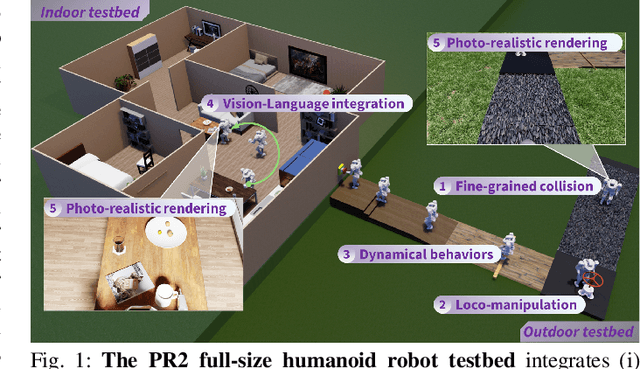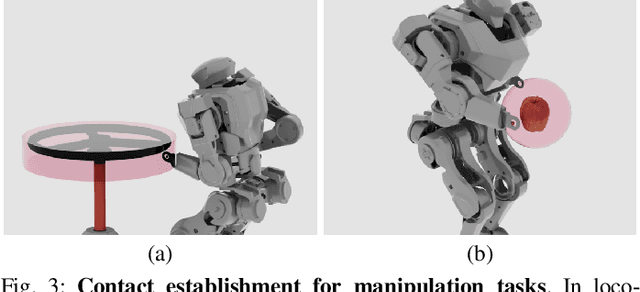Hangxin Liu
In-situ Value-aligned Human-Robot Interactions with Physical Constraints
Aug 11, 2025Abstract:Equipped with Large Language Models (LLMs), human-centered robots are now capable of performing a wide range of tasks that were previously deemed challenging or unattainable. However, merely completing tasks is insufficient for cognitive robots, who should learn and apply human preferences to future scenarios. In this work, we propose a framework that combines human preferences with physical constraints, requiring robots to complete tasks while considering both. Firstly, we developed a benchmark of everyday household activities, which are often evaluated based on specific preferences. We then introduced In-Context Learning from Human Feedback (ICLHF), where human feedback comes from direct instructions and adjustments made intentionally or unintentionally in daily life. Extensive sets of experiments, testing the ICLHF to generate task plans and balance physical constraints with preferences, have demonstrated the efficiency of our approach.
Embedding high-resolution touch across robotic hands enables adaptive human-like grasping
Dec 19, 2024



Abstract:Developing robotic hands that adapt to real-world dynamics remains a fundamental challenge in robotics and machine intelligence. Despite significant advances in replicating human hand kinematics and control algorithms, robotic systems still struggle to match human capabilities in dynamic environments, primarily due to inadequate tactile feedback. To bridge this gap, we present F-TAC Hand, a biomimetic hand featuring high-resolution tactile sensing (0.1mm spatial resolution) across 70% of its surface area. Through optimized hand design, we overcome traditional challenges in integrating high-resolution tactile sensors while preserving the full range of motion. The hand, powered by our generative algorithm that synthesizes human-like hand configurations, demonstrates robust grasping capabilities in dynamic real-world conditions. Extensive evaluation across 600 real-world trials demonstrates that this tactile-embodied system significantly outperforms non-tactile alternatives in complex manipulation tasks (p<0.0001). These results provide empirical evidence for the critical role of rich tactile embodiment in developing advanced robotic intelligence, offering new perspectives on the relationship between physical sensing capabilities and intelligent behavior.
MiniTac: An Ultra-Compact 8 mm Vision-Based Tactile Sensor for Enhanced Palpation in Robot-Assisted Minimally Invasive Surgery
Oct 30, 2024Abstract:Robot-assisted minimally invasive surgery (RAMIS) provides substantial benefits over traditional open and laparoscopic methods. However, a significant limitation of RAMIS is the surgeon's inability to palpate tissues, a crucial technique for examining tissue properties and detecting abnormalities, restricting the widespread adoption of RAMIS. To overcome this obstacle, we introduce MiniTac, a novel vision-based tactile sensor with an ultra-compact cross-sectional diameter of 8 mm, designed for seamless integration into mainstream RAMIS devices, particularly the Da Vinci surgical systems. MiniTac features a novel mechanoresponsive photonic elastomer membrane that changes color distribution under varying contact pressures. This color change is captured by an embedded miniature camera, allowing MiniTac to detect tumors both on the tissue surface and in deeper layers typically obscured from endoscopic view. MiniTac's efficacy has been rigorously tested on both phantoms and ex-vivo tissues. By leveraging advanced mechanoresponsive photonic materials, MiniTac represents a significant advancement in integrating tactile sensing into RAMIS, potentially expanding its applicability to a wider array of clinical scenarios that currently rely on traditional surgical approaches.
M3Bench: Benchmarking Whole-body Motion Generation for Mobile Manipulation in 3D Scenes
Oct 15, 2024



Abstract:We propose M^3Bench, a new benchmark of whole-body motion generation for mobile manipulation tasks. Given a 3D scene context, M^3Bench requires an embodied agent to understand its configuration, environmental constraints and task objectives, then generate coordinated whole-body motion trajectories for object rearrangement tasks. M^3Bench features 30k object rearrangement tasks across 119 diverse scenes, providing expert demonstrations generated by our newly developed M^3BenchMaker. This automatic data generation tool produces coordinated whole-body motion trajectories from high-level task instructions, requiring only basic scene and robot information. Our benchmark incorporates various task splits to assess generalization across different dimensions and leverages realistic physics simulation for trajectory evaluation. Through extensive experimental analyses, we reveal that state-of-the-art models still struggle with coordinated base-arm motion while adhering to environment-context and task-specific constraints, highlighting the need to develop new models that address this gap. Through M^3Bench, we aim to facilitate future robotics research towards more adaptive and capable mobile manipulation in diverse, real-world environments.
M2Diffuser: Diffusion-based Trajectory Optimization for Mobile Manipulation in 3D Scenes
Oct 15, 2024



Abstract:Recent advances in diffusion models have opened new avenues for research into embodied AI agents and robotics. Despite significant achievements in complex robotic locomotion and skills, mobile manipulation-a capability that requires the coordination of navigation and manipulation-remains a challenge for generative AI techniques. This is primarily due to the high-dimensional action space, extended motion trajectories, and interactions with the surrounding environment. In this paper, we introduce M2Diffuser, a diffusion-based, scene-conditioned generative model that directly generates coordinated and efficient whole-body motion trajectories for mobile manipulation based on robot-centric 3D scans. M2Diffuser first learns trajectory-level distributions from mobile manipulation trajectories provided by an expert planner. Crucially, it incorporates an optimization module that can flexibly accommodate physical constraints and task objectives, modeled as cost and energy functions, during the inference process. This enables the reduction of physical violations and execution errors at each denoising step in a fully differentiable manner. Through benchmarking on three types of mobile manipulation tasks across over 20 scenes, we demonstrate that M2Diffuser outperforms state-of-the-art neural planners and successfully transfers the generated trajectories to a real-world robot. Our evaluations underscore the potential of generative AI to enhance the generalization of traditional planning and learning-based robotic methods, while also highlighting the critical role of enforcing physical constraints for safe and robust execution.
M${}^{3}$Bench: Benchmarking Whole-body Motion Generation for Mobile Manipulation in 3D Scenes
Oct 09, 2024



Abstract:We propose M^3Bench, a new benchmark for whole-body motion generation for mobile manipulation tasks. Given a 3D scene context, M^3Bench requires an embodied agent to understand its configuration, environmental constraints and task objectives, then generate coordinated whole-body motion trajectories for object rearrangement tasks. M^3Bench features 30k object rearrangement tasks across 119 diverse scenes, providing expert demonstrations generated by our newly developed M^3BenchMaker. This automatic data generation tool produces coordinated whole-body motion trajectories from high-level task instructions, requiring only basic scene and robot information. Our benchmark incorporates various task splits to assess generalization across different dimensions and leverages realistic physics simulation for trajectory evaluation. Through extensive experimental analyses, we reveal that state-of-the-art models still struggle with coordinated base-arm motion while adhering to environment-context and task-specific constraints, highlighting the need to develop new models that address this gap. Through M^3Bench, we aim to facilitate future robotics research towards more adaptive and capable mobile manipulation in diverse, real-world environments.
AI Delegates with a Dual Focus: Ensuring Privacy and Strategic Self-Disclosure
Sep 26, 2024



Abstract:Large language model (LLM)-based AI delegates are increasingly utilized to act on behalf of users, assisting them with a wide range of tasks through conversational interfaces. Despite their advantages, concerns arise regarding the potential risk of privacy leaks, particularly in scenarios involving social interactions. While existing research has focused on protecting privacy by limiting the access of AI delegates to sensitive user information, many social scenarios require disclosing private details to achieve desired outcomes, necessitating a balance between privacy protection and disclosure. To address this challenge, we conduct a pilot study to investigate user preferences for AI delegates across various social relations and task scenarios, and then propose a novel AI delegate system that enables privacy-conscious self-disclosure. Our user study demonstrates that the proposed AI delegate strategically protects privacy, pioneering its use in diverse and dynamic social interactions.
PR2: A Physics- and Photo-realistic Testbed for Embodied AI and Humanoid Robots
Sep 03, 2024



Abstract:This paper presents the development of a Physics-realistic and Photo-\underline{r}ealistic humanoid robot testbed, PR2, to facilitate collaborative research between Embodied Artificial Intelligence (Embodied AI) and robotics. PR2 offers high-quality scene rendering and robot dynamic simulation, enabling (i) the creation of diverse scenes using various digital assets, (ii) the integration of advanced perception or foundation models, and (iii) the implementation of planning and control algorithms for dynamic humanoid robot behaviors based on environmental feedback. The beta version of PR2 has been deployed for the simulation track of a nationwide full-size humanoid robot competition for college students, attracting 137 teams and over 400 participants within four months. This competition covered traditional tasks in bipedal walking, as well as novel challenges in loco-manipulation and language-instruction-based object search, marking a first for public college robotics competitions. A retrospective analysis of the competition suggests that future events should emphasize the integration of locomotion with manipulation and perception. By making the PR2 testbed publicly available at https://github.com/pr2-humanoid/PR2-Platform, we aim to further advance education and training in humanoid robotics.
Large-scale Deployment of Vision-based Tactile Sensors on Multi-fingered Grippers
Aug 05, 2024Abstract:Vision-based Tactile Sensors (VBTSs) show significant promise in that they can leverage image measurements to provide high-spatial-resolution human-like performance. However, current VBTS designs, typically confined to the fingertips of robotic grippers, prove somewhat inadequate, as many grasping and manipulation tasks require multiple contact points with the object. With an end goal of enabling large-scale, multi-surface tactile sensing via VBTSs, our research (i) develops a synchronized image acquisition system with minimal latency,(ii) proposes a modularized VBTS design for easy integration into finger phalanges, and (iii) devises a zero-shot calibration approach to improve data efficiency in the simultaneous calibration of multiple VBTSs. In validating the system within a miniature 3-fingered robotic gripper equipped with 7 VBTSs we demonstrate improved tactile perception performance by covering the contact surfaces of both gripper fingers and palm. Additionally, we show that our VBTS design can be seamlessly integrated into various end-effector morphologies significantly reducing the data requirements for calibration.
Flight Structure Optimization of Modular Reconfigurable UAVs
Jul 04, 2024



Abstract:This paper presents a Genetic Algorithm (GA) designed to reconfigure a large group of modular Unmanned Aerial Vehicles (UAVs), each with different weights and inertia parameters, into an over-actuated flight structure with improved dynamic properties. Previous research efforts either utilized expert knowledge to design flight structures for a specific task or relied on enumeration-based algorithms that required extensive computation to find an optimal one. However, both approaches encounter challenges in accommodating the heterogeneity among modules. Our GA addresses these challenges by incorporating the complexities of over-actuation and dynamic properties into its formulation. Additionally, we employ a tree representation and a vector representation to describe flight structures, facilitating efficient crossover operations and fitness evaluations within the GA framework, respectively. Using cubic modular quadcopters capable of functioning as omni-directional thrust generators, we validate that the proposed approach can (i) adeptly identify suboptimal configurations ensuring over-actuation while ensuring trajectory tracking accuracy and (ii) significantly reduce computational costs compared to traditional enumeration-based methods.
 Add to Chrome
Add to Chrome Add to Firefox
Add to Firefox Add to Edge
Add to Edge